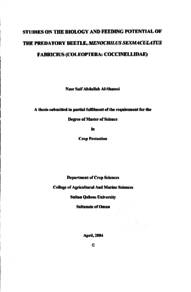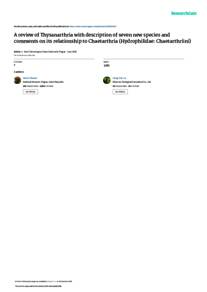Document
Studies on the biology and feeding potential of the predatory beetle, Menochilus Sexmaculatus Fabricius (Coleoptera : Coccinellidae)
Publisher
Sultan Qaboos University
Gregorian
2004
Language
English
Subject
English abstract
Studies on the biology and feeding potential of the predatory coccinellid, Menochilus sexmaculatus were carried out in the laboratory (21 ° C and 68% RH) and the greenhouse (15-25° C and 40-70% RH). The life cycle duration (from egg deposition until adult emergence) was 19.35 +1.11 days. The females lived for 90.5 = 7.53 days, whereas the males lived for 79.75 +7.93 days. The egg, larval and pupal stages lasted for 4.41 +0.51, 9.65 0.61 and 5.29 + 0.59 days, respectively. In the greenhouse, the life cycle duration was 19.13 + 1.36 days. The egg, larval and pupal stages lasted for 4.63 + 0.52, 8.50 + 0.53 and 6.00 = 0.76 days, respectively. The larvae of M sexmaculatus consumed 446.78 275.95 individuals of the cucumber aphids, Aphis gossypii, whereas the adult females and males consumed 5891.60 £700.40 and 4380.83 + 506.20 aphids, respectively. Age of larvae and adults of the predator greatly affected their feeding potential. There was a general decline in food consumption by the adults with the increase in their age. The females of M. sexmaculatus laid 938.89 eggs throughout their life span with 79.26% hatching percentage. Parthenogenesis was observed in this predator but the numbers of eggs produced were negligible. Age had a negative effect on fecundity of the predator. The predator has a wide host range but the cabbage aphid, Brevicoryne brassicae was not a preferred host for it. Temperatures of 30 and 35° C greatly increased the rate of development of different life stages of M sexmaculatus and thus decreased their developmental durations. However, decrease in egg hatching and larval survival were also observed within this range. The preferred range of temperature for rearing the predator was 15 to 25° C. Egg cannibalism by the larvae of M. sexmaculatus was noticed, and the 4th instar larvae, when starved, formed the greatest risk to the eggs. The adults of M sexmaculatus lived for a shorter time when fed on bee pollen, sweetened agar and bee honey than when fed on natural food (aphids).
Description
Thesis
Member of
Resource URL
Arabic abstract
تم إجراء دراسات حول بيولوجية وقدرة الإغتذاء لحشرة أبو العيد Memochilus sexmaculatus Fabricius المنتمية إلى عائلة Coccinellidae وذلك تحت ظروف المعمل (۲۱°م ونسبة رطوبة 68%) و البيت المحمي (15 °م - ۲۵ هم ونسبة رطوبة .4- ۷۰%). في المعمل أكمل المفترس (حشرة أبو العيد) دورة حياته ( من وضع البيض حتى خروج الحشرة الكاملة) في ۱۹٫۳۰۷٫۹۳ يوم عندما تغذي على من الخيار Aphis gossypiعاشت أنثي المفترس مدة ۹۰٫5 ۷ , ۰۳ يوم، بينما عاش الذكر مدة ۷۹٫۷5+ ۷٫۹۳ يوم. أما مراحل حياة المفترس المختلفة: البيض و اليرقة والعذراء فقد إستغرقت 4 , 41 + ۰٫۰۱ و ۹٫65 + ۰. ۱۱ و 5 , ۲۹ + 59. أيام، على التوالي. في البيت المحمي، أكمل المفترس دورة حياته في ۱۹٫۱۳+ ۱٫۳۹ يوم، أما مراحل حياته المختلفة: البيض و اليرقة و العذراء فقد إستغرقت 4
, 63 + ۰٫۰۲ و ۸ , ۵۰ + ۰٫۵۳ و 766 , ۰۰ ,. أيام ، على التوالي. فيما يتعلق بقدرة الإغتذاء للمفترس (أبو العيد) فقد إستطاع الإغتذاء على 446٫۷۸ + ۷۵, ۹۰ فرد من حشرة من الخيار A , gossypii خلال فترة حياة البرقة ، بينما إستطاعت أنثى الحشرة الكاملة الإعتداء على ۵۸۹۱۶۶۰ + ۷۰۰ , 40 فرد واستطاع الذكر الإغتذاء على 4۳۸۰, ۸۳ + 506 , ۲۰ فرد من حشرة من الخيار، خلال فترة حياتهما. التقدم في عمر اليرقة والحشرة الكاملة كان له تأثير كبير على قدرتهما على الإغتذاء، مع تقدم عمر الحشرة الكاملة كان هناك إنخفاض تدريجي في الكمية المتغذي عليها. فيما يخص خصوبة أنثى المفترس فقد إستطاعت وضع ۹۳۸٫۸۹ بيضة خلال فترة حياتها مع نسبة فقس بلغت ۷۹٫۲6%. التقدم في عمر الأنثى كان له أثر سلبي على كمية البيض الموضوعة. التناسل العذري (Parthenogenesis) تم ملاحظته خلال هذه الدراسة ولكن كمية البيض الموضوعة كانت قليلة جدا بالمقارنة مع الكمية الموضوعة من خلال عملية التزاوج. للمفترس (أبو العيد) عوائل كثيرة يتغذى عليها من حشرات المن وغيرها ولكن حشرة من الملفوف Brevicoryne brassicae كانت غير مفضلة لديه. درجة الحرارة العالية (۳۰ و ۳۰ °م) زادت بشكل كبير من سرعة نمو مختلف مراحل المفترس، وهو ما أدي بالتالي إلى تقصير فترة حياتها، ولكنه كان مصحوبا بإنخفاض كبير في نسبة فقس البيض و ارتفاع في نسبة نفوق اليرقات. درجة الحرارة المفضلة لإكثار المفترس تتراوح ما بين 15° م و ۲۰° م. خاصية إفتراس الحشرة البيضها، خاصة عند عدم توفر الغذاء، كانت ملاحظة. تمت ملاحظة ذلك في هذه الدراسة على يرقات المفترس، حيث تبين أن يرقة الطور الرابع تمثل الخطر الأكبر على بيض الأنثى خاصةعند عدم توفر الغذاء. الحشرات الكاملة للمفترس عاشت لفترة أقصر عند تغذيتها على حبوب لقاح نحل العسل أو الأجار المحلي بالعسل أو عسل النحل، عنها عند تغذيتها على غذائها الطبيعي وهو حشرة المن.
, 63 + ۰٫۰۲ و ۸ , ۵۰ + ۰٫۵۳ و 766 , ۰۰ ,. أيام ، على التوالي. فيما يتعلق بقدرة الإغتذاء للمفترس (أبو العيد) فقد إستطاع الإغتذاء على 446٫۷۸ + ۷۵, ۹۰ فرد من حشرة من الخيار A , gossypii خلال فترة حياة البرقة ، بينما إستطاعت أنثى الحشرة الكاملة الإعتداء على ۵۸۹۱۶۶۰ + ۷۰۰ , 40 فرد واستطاع الذكر الإغتذاء على 4۳۸۰, ۸۳ + 506 , ۲۰ فرد من حشرة من الخيار، خلال فترة حياتهما. التقدم في عمر اليرقة والحشرة الكاملة كان له تأثير كبير على قدرتهما على الإغتذاء، مع تقدم عمر الحشرة الكاملة كان هناك إنخفاض تدريجي في الكمية المتغذي عليها. فيما يخص خصوبة أنثى المفترس فقد إستطاعت وضع ۹۳۸٫۸۹ بيضة خلال فترة حياتها مع نسبة فقس بلغت ۷۹٫۲6%. التقدم في عمر الأنثى كان له أثر سلبي على كمية البيض الموضوعة. التناسل العذري (Parthenogenesis) تم ملاحظته خلال هذه الدراسة ولكن كمية البيض الموضوعة كانت قليلة جدا بالمقارنة مع الكمية الموضوعة من خلال عملية التزاوج. للمفترس (أبو العيد) عوائل كثيرة يتغذى عليها من حشرات المن وغيرها ولكن حشرة من الملفوف Brevicoryne brassicae كانت غير مفضلة لديه. درجة الحرارة العالية (۳۰ و ۳۰ °م) زادت بشكل كبير من سرعة نمو مختلف مراحل المفترس، وهو ما أدي بالتالي إلى تقصير فترة حياتها، ولكنه كان مصحوبا بإنخفاض كبير في نسبة فقس البيض و ارتفاع في نسبة نفوق اليرقات. درجة الحرارة المفضلة لإكثار المفترس تتراوح ما بين 15° م و ۲۰° م. خاصية إفتراس الحشرة البيضها، خاصة عند عدم توفر الغذاء، كانت ملاحظة. تمت ملاحظة ذلك في هذه الدراسة على يرقات المفترس، حيث تبين أن يرقة الطور الرابع تمثل الخطر الأكبر على بيض الأنثى خاصةعند عدم توفر الغذاء. الحشرات الكاملة للمفترس عاشت لفترة أقصر عند تغذيتها على حبوب لقاح نحل العسل أو الأجار المحلي بالعسل أو عسل النحل، عنها عند تغذيتها على غذائها الطبيعي وهو حشرة المن.
Category
Theses and Dissertations


